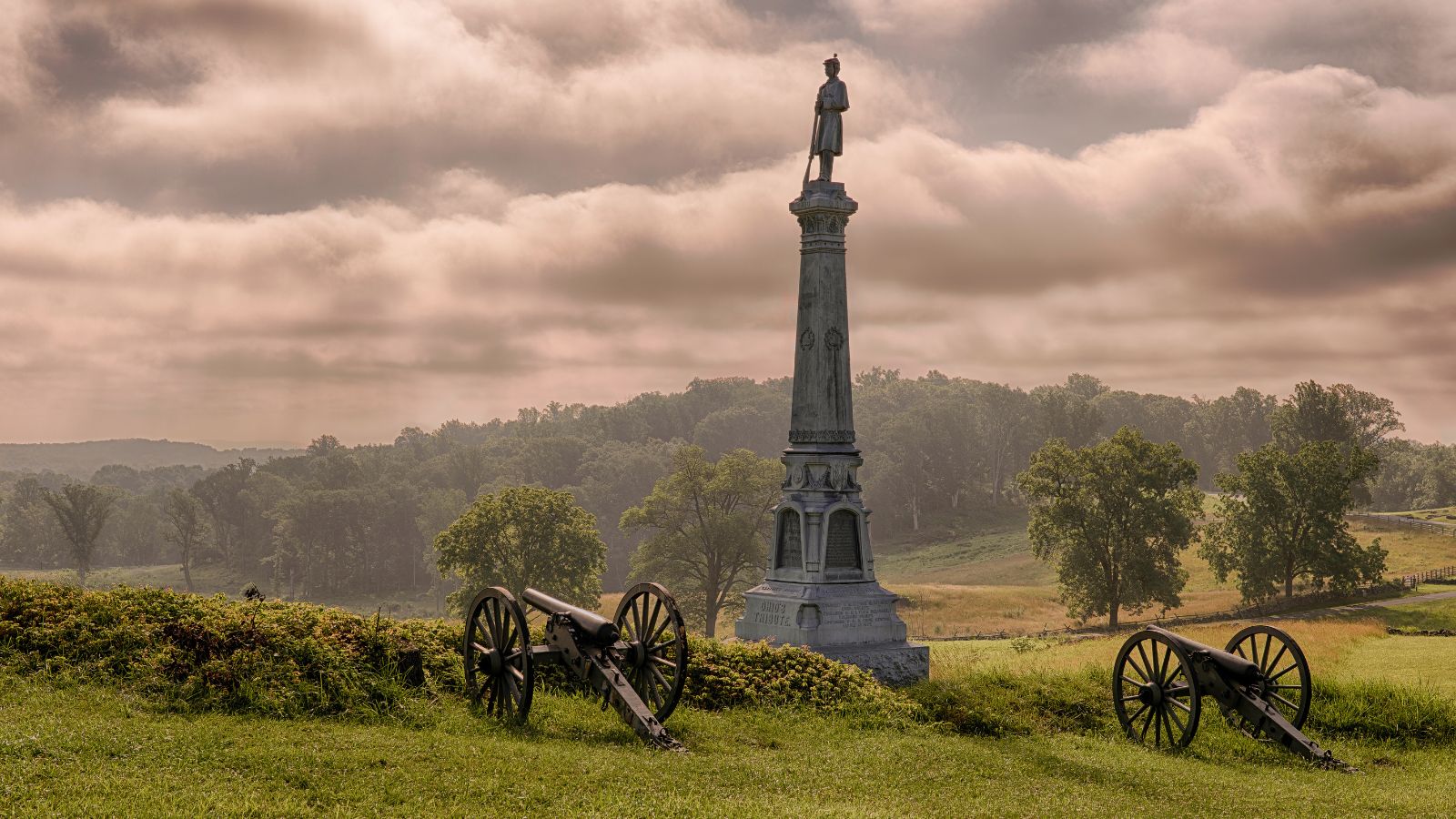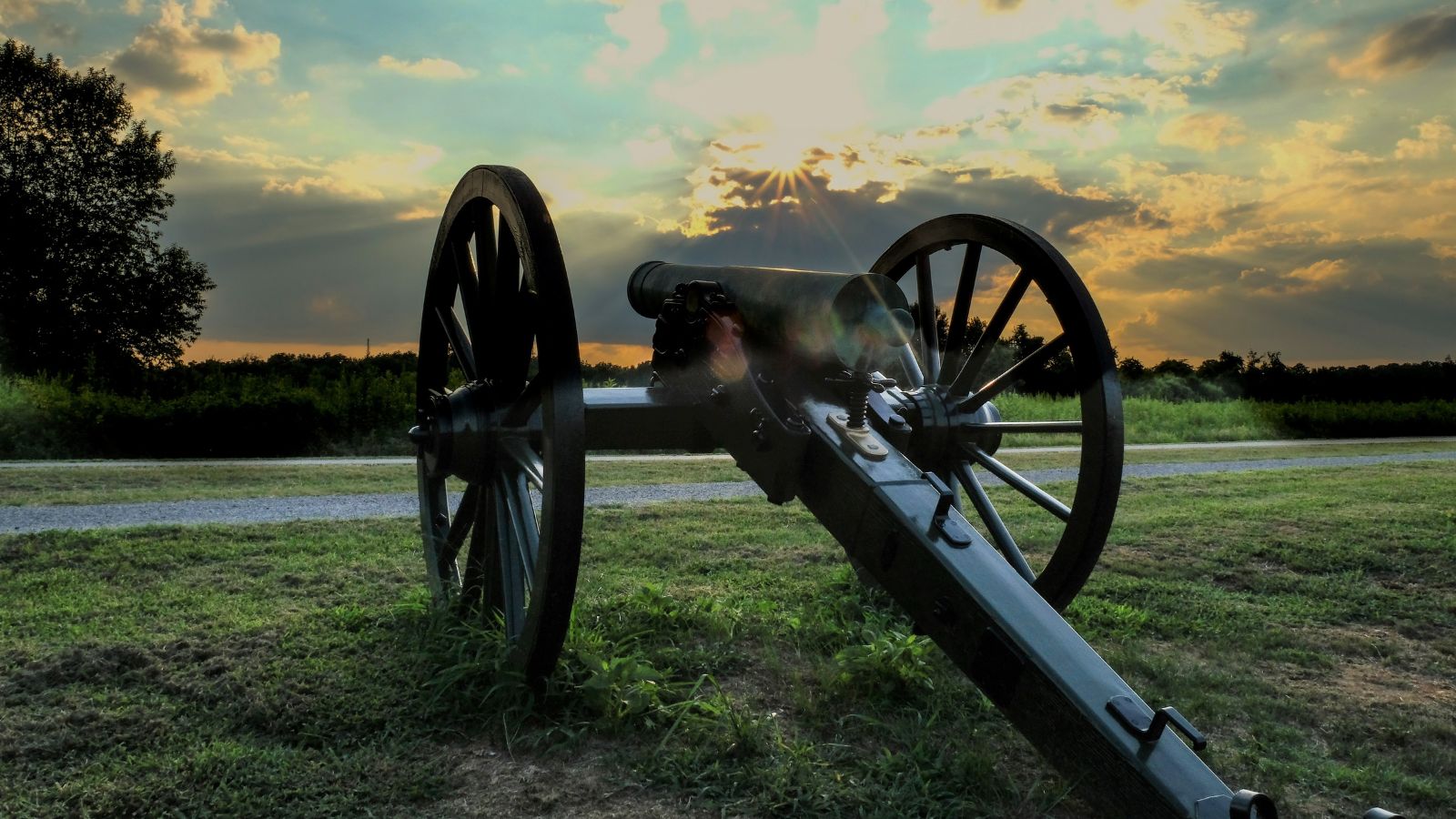Fought between 1861 and 1865, the Civil War was a long and brutal war that saw thousands of soldiers lose their lives over numerous bloody battles. These 17 battlefields are full of history, and now visitors flock to learn more about their pasts at museums, visitor centers, and preserved sites.
Gettysburg Battlefield

Fought in 1863, the Battle of Gettysburg is often considered the turning point of the Civil War. According to the National Park Service, “Gettysburg was the Civil War’s bloodiest battle and was also the inspiration for President Abraham Lincoln’s immortal ‘Gettysburg Address.’” Today, visitors can learn from a museum at the site, which offers extensive exhibits.
Antietam National Battlefield

The Battle of Antietam was fought on September 17, 1862, and was the single bloodiest day in American military history, leading to President Lincoln issuing the preliminary Emancipation Proclamation. Today, the battlefield offers a self-guided auto tour, numerous walking trails, and the Pry House Field Hospital Museum, showcasing medical history during the Civil War.
Manassas National Battlefield Park

This park encompasses the sites of two crucial Civil War battles, both Confederate victories, which had significant impacts on the early part of the war. The park offers visitors a range of activities, including guided tours, hiking trails, and living history demonstrations, providing insights into 19th-century life and the realities of war.
Fort Sumter National Monument

Fort Sumter is where the first shots of the Civil War were fired in April 1861, setting the stage for years of conflict. Brittanica says, “Fort Sumter was designed as part of the defensive system protecting Charleston, South Carolina.” Visitors can access the fort via boat tours and learn about its history, the attack, and its aftermath.
Shiloh National Military Park

An early large-scale engagement in the Western Theatre, the Battle of Shiloh saw a significant Union victory and a high number of casualties. Now a tourist hotspot, the park provides educational programs, historical reenactments, and a visitor center with exhibits on the battle’s details, the soldiers’ experiences, and the broader war.
Vicksburg National Military Park

The Siege of Vicksburg in 1863 was a pivotal Union victory, giving them control of the Mississippi River and splitting the Confederacy. The park is now known for its annual reenactments and living history events, where visitors can experience military camps, watch battlefield demonstrations, and learn about civilian life during the siege.
Fredericksburg and Spotsylvania National Military Park

Commemorating four major battles—Fredericksburg, Chancellorsville, Wilderness, and Spotsylvania—this park marks some of the most intense fighting of the Civil War. There have been efforts to preserve the battlefields, including maintaining historic buildings, landscapes, and the infamous Sunken Road at Fredericksburg, for visitors to explore.
Chickamauga and Chattanooga National Military Park

This park commemorates the Battle of Chickamauga, the Civil War’s second bloodiest battle that ended in Confederate victory. The American Battlefield Trust says, “Chickamauga’s numerous monuments and markers, driving tours and trails, and observation towers make visiting Chickamauga an inspiring experience for Civil War buffs and nature enthusiasts alike.”
Petersburg National Battlefield

The lengthy Siege of Petersburg involved trench warfare and crucial battles, ultimately leading to the fall of Richmond and the end of the Civil War. Visitors to the park can explore numerous trails, participate in guided tours, and visit the visitor center to learn about the siege’s strategies, daily soldier life, and the eventual Union breakthrough.
Stones River National Battlefield

Fought from December 1862 to January 1863, the Battle of Stones River had one of the highest casualty rates of the war, influencing morale and military momentum in the Union’s favor. Today, visitors can see the Stones River National Cemetery and numerous monuments across the battlefield that honor the fallen soldiers.
Appomattox Court House National Historical Park

Appomattox Court House National Historical Park marks the site of General Robert E. Lee’s surrender to General Ulysses S. Grant in April 1865, effectively ending the Civil War. Visitors to the park can explore the restored village of Appomattox, including the McLean House where the surrender occurred.
Richmond National Battlefield Park

According to the National Park Foundation, “As the industrial and political capital of the Confederacy, Richmond was the physical and psychological prize over which two mighty American armies contended in bloody battle from 1861 to 1865.” There are several visitor centers in the park, including Tredegar Iron Works.
Harpers Ferry National Historical Park

Known for John Brown’s 1859 raid and its strategic importance during the Civil War, Harpers Ferry is noted for its scenic beauty, with trails and views of the Potomac and Shenandoah Rivers. Visitors can experience living history demonstrations, museums, and exhibits that showcase the town’s history, the raid, and its Civil War experiences.
Pea Ridge National Military Park

A pivotal Union victory in 1862, the Battle of Pea Ridge secured Missouri and influenced control of the Mississippi River. The team at the park has preserved the battlefield’s terrain, offering visitors a sense of the battle’s scale and context, and a visitor center provides detailed exhibits on the battle and the tactics employed.
Wilson’s Creek National Battlefield

One of the first major engagements west of the Mississippi River, the 1861 Battle of Wilson’s Creek was a significant Confederate victory in the early war. The site is well preserved, and Visit Missouri says, “Walking trails lead to various battle sites, including Bloody Hill, the Historic John Ray House and the Edwards Cabin.”
Franklin Battlefield

Fought on November 30, 1864, the Battle of Franklin was among the war’s bloodiest battles, with significant casualties and a pivotal Union victory. There are many sites for visitors to experience, including the Carter House and Carnton, which served as field hospitals.
Bentonville Battlefield

The largest battle in North Carolina, the 1865 Battle of Bentonville was one of the Confederacy’s final attempts to defeat Sherman’s forces. The landscape of the battlefield has been well preserved and provides a vivid backdrop for understanding the battle’s tactics and the challenges faced by both sides.
Read More: Why People Aren’t Religious Anymore: 15 Simple Reasons

As society evolves, so does our approach to spirituality. This article looks at the subtle yet profound shift from traditional religious adherence to a more personal, evidence-based belief system.
Why People Aren’t Religious Anymore: 15 Simple Reasons
17 American Attractions That Not Even Americans Want to Visit

The United States of America—land of the free, home of the brave, and the location of some of the most ‘unique’ tourist attractions you’ll ever lay eyes on.
Get ready to chuckle, scratch your head, and maybe even facepalm as we look at 17 American attractions that not even Americans think are worth visiting.
17 American Attractions That Not Even Americans Want to Visit
17 Fairy Tales That Are Now Considered Racist

While fairy tales weave magical narratives that span generations, many emerge from historical and cultural contexts tinged with biases. Hiding in many of these tales, racial undertones can be found. Let’s look at 17 fairy tales that have deeper implications.
17 Fairy Tales That Are Now Considered Racist
18 Common Traits Found in Adults Who Had Unhappy Childhoods

Being a parent is a hard job, so even those who are truly trying their best will often miss the mark on creating the best environment for their children. Unfortunately, this means that many of us grow up with far-from-perfect childhoods that affect us into adulthood. Here are 18 common traits found in adults who had unhappy childhoods.
18 Common Traits Found in Adults Who Had Unhappy Childhoods
18 Things Old People Just Can’t Get On Board with Today

Over the past few decades, society has evolved, and with it, so have a few things that older generations find it uncomfortable to get the hang of. While younger generations are easily able to adapt to these changes, some of which are drastic, others may be struggling slightly. Here are 18 things the elderly may have difficulty learning.
